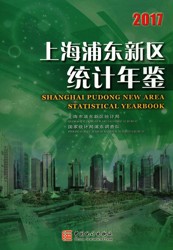一、《上海浦东新区统计年鉴—2017》是一部集浦东新区资料于一体的大型工具书。全书通过大量的统计数据,以中英文对照的形式记录了浦东新区开发开放以来社会经济发展的历程,全面展示了2016年浦东新区在二次创业的新阶段中,经济、社会、科技和重点开发区等各方面的发展变化。年鉴为各级领导、理论研究和实际工作者,以及国内外各界关心浦东开发开放的人士了解浦东、研究浦东、参与浦东开发建设提供了案头工具。
二、2009年,浦东新区行政体制发生重大变化。4月24日,国务院批准南汇区行政区域划入浦东新区。5月6日,上海市人民政府正式宣布两区合并。由于两区以前年度很多数据在统计方法、统计口径、统计范围等方面的不一致,数据无法简单相加,追溯存在一定难度。因此除特别注明外,本年鉴自2009年起,统计数据均为新浦东数据(即含原南汇地区),以前年度仍为原浦东数据。
三、2011年和2012年,浦东新区进行部分街镇行政区划调整。2011年10月28日,上海市人民政府批准撤销川沙新镇、六灶镇建制,设立新的川沙新镇;撤销祝桥镇建制,设立新的祝桥镇,其行政区域范围作相应调整。2012年8月30日,经批准撤销申港街道、芦潮港镇建制,设立南汇新城镇,同时行政区域范围也作相应调整。
四、本年鉴中平均增长速度根据每年的环比增长速度相乘再开方得到。
五、全书内容分为二十一个篇目。内含:1.综合;2.人口;3.固定资产投资;4.招商引资;5.农业;6.工业;7.建筑业;8.金融业及要素市场;9.房地产;10.国内外贸易;11.服务、旅游和住宿业;12.科学技术;13.人民生活;14.就业与社会保障;15.教育;16.文化和体育;17.卫生;18.法律、社会治安及其他;19.城市建设和环境保护;20.重点开发区和街镇;21.上海市统计资料。
六、资料中使用的度量衡单位均采用国际统一标准计量单位。
七、本年鉴部分数据总计数或相对数由于单位取舍不同,产生的计算误差均未作机械调整。
八、浦东新区在行政管理体制上于1995年11月撤乡建镇,实行镇管村体制。因此,本年鉴中有关“镇”和“镇及镇以上工业”等指标含义与全国的“乡”和“乡及乡以上工业”等指标的含义相同。
九、本年鉴中的符号使用说明:“#”表示某一指标的其中主要项;“…”表示数据不足本表最小计量单位数;“空格”表示该项统计指标数据不详或无该项数据或数据为零。
十、根据国务院和国家统计局有关我国GDP核算和数据发布制度的规定,浦东新区国内生产总值自2004年起更名为“浦东新区生产总值”,简称“新区生产总值”。
十一、本年鉴中各项增加值和总产值绝对数均按当年价格计算,增长速度按可比价格计算。
十二、在使用统计资料时,凡与本年鉴有出入的,均以本年鉴为准。
十三、《上海浦东新区统计年鉴》公开出版以来,受到国内外广大读者的爱护和支持,对此我们深表谢意,并竭诚欢迎读者继续对本年鉴的不足之处给予批评和指正。
本年鉴的编制得到了上海市统计局、浦东新区各委、办、局及各开发区管委会等有关单位的大力支持,在此一并表示谢意。
Ⅰ.Statistical Yearbook of Shanghai Pudong New Area(PNA)—2017 is a large,comprehensive reference book.With great amount of data and in both Chinese and English versions,it records recent years' social and economic development in PNA.It describes the changes in economy,society,science and technology,and key development zones in PNA's new stage of “Second Startup for Business” in 2016.It is a desktop tool-book meant for leaders at all levels,theorists,practitioners,and people at home and abroad who are interested in PNA,want to do research work on Pudong and intend to participate in its development and its construction.
Ⅱ.Great changes happened to the administrative system of Pudong New Area in 2009.On April 24,the State Council approved to add the administrative area of Nanhui District into Pudong New Area.On May 6,the Shanghai Municipal government formally announced the combination of these two districts.Because of data of previous years in these two districts can not be added simply while they had been produced with different statistical methods,approached and areas and it is hard to trace them.Unless specified,the statistical data in this Yearbook are those of new PNA(including former Nanhui District) since 2009,and the data of previous years are those of former PNA.
Ⅲ.In 2011 and 2012,administrative divisions of some towns in PNA were readjusted.On October 28,2011,Shanghai People's Government approved the establishment of the new Chuansha New Town after rescinding the former Chuansha New Town and Liuzao Town,approved the establishment of the new Zhuqiao Town after rescinding the former Zhuqiao Town,and readjusted the administrative divisions of these two new towns.On August 30,2012,the municipal government approved the establishment of the new Nanhui New Town after rescinding Shengang Sub-district and Luchaogang Town,and readjusted its administrative division.
Ⅳ.The annual average growth rate in this Yearbook is extracted from the multiplication of the annual chain growth rates.
Ⅴ.This book falls into nineteen chapters:1.General Survey;2.Population;3.Investment in Fixed Assets;4.Business Promotion and Foreign-fund Attraction;5.Agriculture;6.Industry;7.Construction;8.Finance and Banking,and Factor Markets;9.Real Estate;10.Domestic and Foreign Trades;11.Services,Tourism and Hotels;12.Science and Technology;13.People's Livelihood;14.Employment and Social Security;15.Education;16.Culture and Sports;17.Public Health;18.Laws,Public Order and Others;19.Urban Construction and Environmental Protection;20.Key Development Zones and Sub-districts and Towns;21.Statistics of Shanghai Municipality.
Ⅵ.The units of measurement in this book are consistent with international standards.
Ⅶ.No adjustment has been made to correct the deviations of some of the figures in the Yearbook caused by different methods used in rounding.
Ⅷ.In November 1995,PNA rescinded township system and adopted town system.Villages are supervised by towns in the town system.Therefore,in this book,the meanings of “town” and“town and town-above industry” are the same as“township” and“township and township-above industry” in other Chinese statistical books.
Ⅸ.Notations used in this Yearbook:
“#”indicates the major item of a certain indicator,
“…”indicates the figure which is too small to be measured by the smallest unit in the table,
“blank” indicates the data unavailable or none in certain statistical indicator.
Ⅹ.According to relevant stipulations by the State Council and National Bureau of Statistics,GDP of Pudong New Area is to be renamed as Gross Output Value of Pudong New Area,shortened as PNA Gross Output Value starting from 2004.
Ⅺ.All added values and gross output vales in the Yearbook are listed in terms of current prices while growth rates listed in terms of comparable prices.
Ⅻ.If any statistical data from other sources conflict with the data in the present Yearbook,datain the present Yearbook shall apply.
ⅩⅢ.The publication of Pudong New Area Statistical Yearbook has received great attention.Our gratitude and appreciation go to all the readers who have offered their comments.We welcome and are open to more comments and suggestions from our readers when presenting this new edition.
We appreciate the great support and efforts of Shanghai Statistics Bureau,all the commissions,offices and bureaus,and administrations of all the development zones in PNA during compilation of the present Yearbook.
